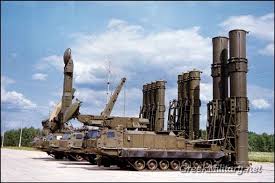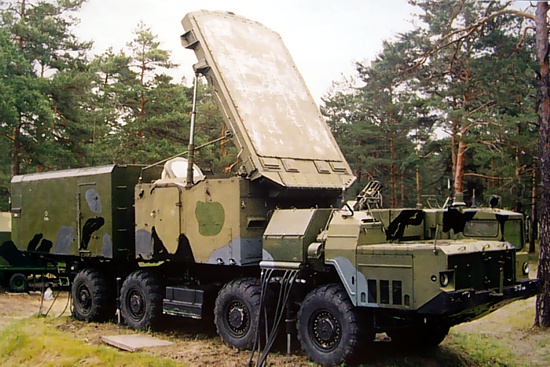There are currently three main variations: S-300V, S-300P and S-300F
The V suffix stands for Voyska (ground forces): top tier army air defence system, providing a defence against ballistic missiles, cruise missiles and aircraft. The S-300V system is carried on tracked MT-T transporters. 9M83 "GLADIATOR" missiles have a maximum engagement range of around 75 km (47 mi) while the 9M82 "GIANT" missiles can engage targets out to 100 km (62 mi) and up to altitudes of around 32 km (100,000 ft).The S-300V places a greater emphasis on the ABM, with the dedicated 9M82 (SA-12B Giant) Anti-Ballistic missile
The S-300P is the original version of the S-300 system. The P suffix stand for PVO-Strany (country air defence system). It was originally intended to fit the Track Via Missile (TVM) guidance system onto this model. However, the TVM system had problems tracking targets below 500 m. Rather than accept the limitation, the Soviets decided that the tracking of low altitude targets was a must and decided to use a pure command-guidance system until the TVM head was ready.[5] This allowed the minimum engagement altitude to be set at 25 m. Improvements to the S-300P have resulted in several major subversions for both the internal and the export market. The S-300PT-1 and S-300PT-1A (SA-10b/c) are incremental upgrades of the original S300PT system. They introduce the 5V55KD missile with a range of 75 km. The S-300PS/S-300PM was introduced in 1985 and featured the new 5V55R missiles, which increased maximum engagement range to 90 km (56 mi) and introduced a terminal semi-active radar homing (SARH) guidance mode. The next modernisation, called the S-300PMU, was introduced in 1992 for the export market and featured the upgraded 5V55U missile which still utilised the intermediate SARH terminal guidance method and smaller warhead of the 5V55R but increased the engagement envelope to give this missile roughly the same range and altitude capabilities as the newer 48N6 missile (max. range 150 km/93 mi). In addition to the 5V55R and 48N6E missiles the S-300PMU-1 can utilise two new missiles, the 9M96E1 and 9M96E2. Both are significantly smaller than the previous missiles at 330 and 420 kg (728 and 926 lb respectively) and carry smaller 24 kg (53 lb) warhead. The 9M96E1 has an engagement range of 1–40 km (1–25 mi) and the 9M96E2 of 1–120 km (1–75 mi).The S-300PMU-2 Favorite (Russian С-300ПМУ-2 Фаворит – Favourite, DoD designation SA-20B), introduced in 1997, is an upgrade to the S-300PMU-1 with range extended once again to 195 km (121 mi) with the introduction of the 48N6E2 missile
The S-300F Fort, F suffix for Flot (Russian for fleet) was introduced in 1984 as the original ship-based (naval) version of the S-300P system, with the new 5V55RM missile with range extended to 7–90 km (4–56 mi, equal to 3.8–50 nautical miles) and maximum target speed up to Mach 4, while engagement altitude was reduced to 25–25,000 m (100-82,000 ft). The S-300FM Fort-M is another naval version of the system, that introduced the new 48N6 missile in 1990. This increased missile speed to approximately Mach 6 for a maximum target engagement speed of up to Mach 8.5, increased the warhead size to 150 kg (330 lb) and increased the maximum engagement range yet again to 5–150 km (3–93 mi) as well as opening the altitude envelope to 10m-27 km (33–88500 ft). The new missiles also introduced the ultimate track-via-missile guidance method and brought with it the ability to intercept short-range ballistic missiles.
So, the question really is .... what missile are we talking about, exactly?
S-300 (missile) - Wikipedia, the free encyclopedia









